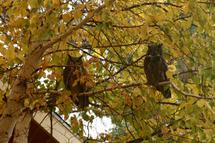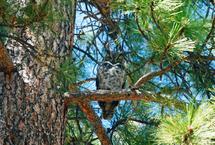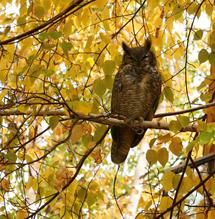saveourplanetearth.com
Call us: (775) 831-1331
Great Horned Owl
The great horned owl is one of the largest and heaviest owls in North America, second only to the snowy owl of the Arctic. This owl is easily distinguished by its size, but also by its prominent ear tufts, called plumicorns.
The owl is nocturnal, hunting mainly at night, but is also crepuscular, hunting at dusk and dawn. During the day, the owl can be seen roosting camouflaged in a tree, perhaps in the “high thin” position, which means it stretches its body to provide a thin silhouette.
During the day, the owl will be sluggish and passive, while remaining alert. Its coloring helps it to blend in with its surroundings: light colored underparts with brown horizontal barring, upper parts and outer wings a deeper mottled brown.
Its feet and legs are black but also covered with feathers. Its bill and talons are dark gun-metal gray. The spread of its feet, from talon to talon is nearly 8 inches which can supply 300 pounds per square inch of crushing power, considerably more than the strongest human.
Mercifully, the great horned owls’ prey is instantly crushed to death with these powerful talons before it is swallowed whole or, as is the case with larger prey, torn apart and swallowed. The owl can capture prey 2 to 3 times heavier than itself, even preying on smaller dogs and cats.
Typically, the owl feeds upon small mammals such as squirrels, rabbits and mice but will also capture porcupines and even skunks. It has been known to raid poultry, and sometimes walks along the ground, seeking reptiles and bugs or will wade into ponds to eat frogs.
An owl has an acute sense of hearing, 10 times greater than a human’s, helping it to locate prey. Its large eyes, fixed firmly in deep sockets, cannot move, so it must move its head, which can swivel as much as 270 degrees.
In addition to these hunting-adaptive traits, the owl has soft wing feathers, allowing it to fly without sound, enabling it to snatch and dispatch prey before it can react.
Approximately 6 to 10 hours after consuming its prey, the owl will regurgitate pellets consisting of bones and other non-digestible bits.
The great horned owl begins courtship and nesting earlier than most birds of prey, in part due to the longer nights and to gain an advantage over other hunters. In this area, mating begins as early as late fall into December, with pairs being established by January or February.
The male courts the female by hooting emphatically, while leaning over and puffing out his throat. Eventually he will approach her and attempt to rub his bill against hers while repeatedly bowing. He may bring her prey, which they will then share. She shows her appreciation of his efforts by hooting back at him.
The male chooses a nesting site and draws her to it by flying to it and stomping on it. As with many birds, owls mate for life but associate more loosely once the chicks become independent.
The owl does not build its own nest, rather it adopts a nest built by animals or birds, and will also nest in the cavity of a tree. Nests are usually 15 to 72 feet above the ground.
The pair defends a territory of approximately 3 square miles by hooting, occasionally resorting to more aggressive behavior with persistent interlopers. Both the male and female defend the territory and both are extremely protective of the nesting site.
DeeDee Boies, Lake Tahoe home owner since 1985 and full-time Incline Village resident since 2007, has a party of Steller’s jays to thank for leading to her discovery of a resident pair of owls. One day last spring she heard a group of Steller’s jays squawking relentlessly so she went outside to investigate. She looked up and saw an owl, resting in a tree, apparently unaffected by the harassment from the noisy jays.
The jays were unsuccessful in driving out the owl, as it has established permanent residence in DeeDee’s neighborhood, along with what appears to be a mate. She has been unable to find a nest and did not see any young, but she has seen them recently and they are likely to remain as the great horned owl is not migratory, except in extreme northern climates.
DeeDee has delighted in observing this pair throughout the summer and into the fall. DeeDee, like many Lake Tahoe residents, finds her muse in nature and can often be found hiking in the forest, camera in hand.
DeeDee is a life coach and teaches meditation at For Goodness Sake, a non-profit spiritual resource center in Truckee. She is also the author and photographer of Seeing Life as a Meditation, available at tahoetshirtsandgifts.com.
Pair of great horned owls, roosting in their favorite tree in central Incline Village
Photo courtesy of DeeDee Boies
The great horned owl’s powerful talons are clearly visible as it roosts during the day
Photo courtesy of DeeDee Boies
Note how well the owl blends into its surroundings
Photo courtesy of DeeDee Boies





